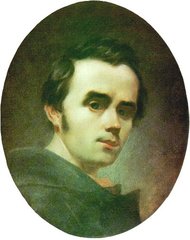Taras Shevchenko
|
|
| Contents |
Life
Born into a serf family in the village of Moryntsi, of Kiev guberniya (then a part of the Russian Empire), Shevchenko was orphaned at the age of eleven. As a child he exhibited talent as a painter and accompanied his owner, P. Engelhardt, in his trips to Vilnius and, later, Saint Petersburg, where Shevchenko received training in painting. His talents were noticed by influential Russian painters who intervened to gain him freedom from serfdom. The famous Russian painter Karl Briullov drew a portrait of his friend, Russian poet Vasily Zhukovsky, and donated a portrait as a prize for the lottery whose proceeds used to buy Shevchenko's freedom from serfdom on May 5, 1838.
First Successes
In the same year Shevchenko was accepted as a student into the Academy of Arts in the workshop of Karl Briullov. The next year he became a resident student at the Association for the Encouragement of Artists. At the annual examinations at the Imperial Academy of Arts, Shevchenko was given a Silver Medal for a landscape. In 1840 he again received the Silver Medal, this time for his first oil painting, The Beggar Boy Giving Bread to a Dog.
He began writing poetry while he was a serf and in 1840 his first collection of poetry, Kobzar, was published. Ivan Franko, the renowned Ukrainian poet in the generation after Shevchenko, had this to say of the compilation: "[Kobzar] immediately revealed, as it were, a new world of poetry. It burst forth like a spring of clear, cold water, and sparkled with a clarity, breadth and elegance of artistic expression not previously known in Ukrainian writing."
In 1841 the epic poem Haidamaky was released. In September 1841 Shevchenko was awarded his third Silver Medal for The Gypsy Fortune Teller. Shevchenko also wrote plays. In 1842 he released a part of the tragedy Nykyta Hayday and in 1843 he completed the drama Nazar Stodolya. After these successes Shevchenko traveled to Ukraine where he saw the difficult conditions under which his compatriots lived.
Exile
On March 22, 1845, the Council of the Academy of Arts decided to grant Shevchenko the title of artist. He again traveled to Ukraine where he met members of the Brotherhood of Saints Cyril and Methodius, a secret political society created to advocate a wide set of political reforms in the Russian Empire. Upon the society suppression by the authorities Shevchenko was arrested on April 5, 1847, along with other members. He was sent to prison in St. Petersburg. As a result of the investigation into this group he was exiled as a private with the Russian military at Orenburg in the remote part of the Russian Empire. Tsar Nicholas I, confirming his sentence, wrote, "Under the strictest surveillance, with a ban on writing and painting." It was not until 1857 that Shevchenko finally returned from exile after receiving a pardon, though he was not permitted to return to St. Peterburg but was exiled to Nizhniy Novgorod. In May, 1859, Shevchenko got permission to go to Ukraine. He intended to buy a plot of land not far from the village of Pekariv and settle in Ukraine. In July he was arrested on a charge of blasphemy, but was released and ordered to return to St. Petersburg.
Death of Shevchenko
Taras Sevchenko spent the last years of his life working on new poetry, paintings, and engravings, as well as editing his older works. But after his difficult years in exile his final illness proved too much and Taras Shevchenko died in St. Petersburg on March 10, 1861. He was first buried at the Smolensk Cemetery in St. Petersburg. However, fulfilling Shevchenko's wish, as expressed in his poem Testament (or, Zapovit), to be buried in Ukraine, his friends arranged to transfer his remains by train to Moscow and then by horse-drawn wagon to his native land. Shevchenko's remains were buried on May 8 on Chernecha Hora (Monk's Hill) (now Tarasova Hora or Taras' Hill) by the Dnieper river near Kaniv. A tall mound was erected over his grave, now a memorial.
Dogged by terrible misfortune in love and life, the poet died seven days before the Emancipation of Serfs was announced. His works and life are revered by Ukrainians and his impact on Ukrainian literature is immense.
Heritage and legacy
There are many monuments to Shevchenko throughout Ukraine, most notably at his memorial in Kaniv and in the center of Kiev, just across the Kiev University that bears his name. Besides, monuments to Shevchenko were built or are being built in many countries, including most of ex-Soviet republics. Under initiative of local Ukrainian diasporas, there are several memorial societies and monuments to him throughout Canada and the United States, most notably a monument in Washington, D.C., near Dupont Circle.
Poetry
Testament
Dig my grave and raise my barrow
By the Dnieper-side
In Ukraina, my own land,
A fair land and wide.
I will lie and watch the cornfields,
Listen through the years
To the river voices roaring,
Roaring in my ears.
When I hear the call
Of the racing flood,
Loud with hated blood,
I will leave them all,
Fields and hills; and force my way
Right up to the Throne
Where God sits alone;
Clasp His feet and pray...
But till that day
What is God to me?
Bury me, be done with me,
Rise and break your chain,
Water your new liberty
With blood for rain.
Then, in the mighty family
Of all men that are free,
Maybe sometimes, very softly,
You will speak of me?
Translated by E. L. Voynich
London, 1911
External links
- Taras Shevchenko Museum, Canada (http://www.infoukes.com/shevchenkomuseum/)
- Detailed Biography in Encyclopedia of Ukraine (http://www.encyclopediaofukraine.com/pages/S/H/ShevchenkoTaras.htm)
- Detailed Biography at The Taras Shevchenko Museum of Canada Web-Site (http://www.infoukes.com/shevchenkomuseum/biography)
- English Translations of the Poetry of Taras Shevchenko (http://www.infoukes.com/shevchenkomuseum/poetry)
- Shevchenko Monument In Washington, D.C., USA (http://www.artukraine.com/taras/monumentp2.htm)
de:Taras Schewtschenko fr:Tarass Chevtchenko uk:Шевченко Тарас Григорович pl:Taras Szewczenko


